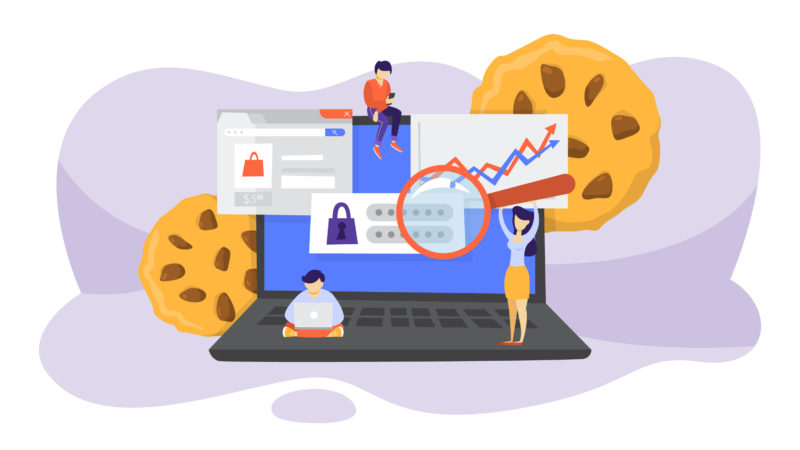What Will Happen in a Third Party Cookie-Free World?

Cookies have been a part of the digital landscape for an eternity (or at least an eternity in the digital marketing sense). However, significant strides have recently been taken by major industry players to remove third-party cookies. This started with Firefox, followed by Safari and most recently, and perhaps most significantly, by Google.
To overcome the serious challenges advertisers and websites reliant on ad-revenue now face, it’s crucial that the new limitations and the available alternative approaches are understood. We’ll explore this in more detail and highlight opportunities and new (or revisited) tactics you need to adopt.
So, what’s happening with third-party cookies?
Under the proviso of improving consumer privacy, Google have announced that they will begin phasing out third-party cookies from Chrome browsers by 2022. Chrome will still allow the collection of first-party cookies – used for web analytics and the likes, and it is important to understand that this is highly unlikely to disappear anytime soon. However, third-party cookies, the ones that allow 3rd parties to target adverts on external sites, will be prohibited.
So, why is this change happening? There has been an increase in scrutiny from consumers, and privacy activists, around the ways companies have been utilising third-party cookies to target advertising. The concerns have centred around the level of transparency and the lack of clear consent being provided by consumers. This scrutiny has led to an increase in the usage of ad-blocking technology, which has expedited the need for advertisers and publishers to identify new ways of serving ads to customers, while reducing the need for third-party cookies.
What impact will third-party cookie removal have on advertisers?
As with any shift away from the status-quo, advertisers will be asking themselves – “what impact will this have on me and my digital activity?”. To a degree this is still unknown, but it will likely expedite a move away from behavioural advertising (using consumers’ online behaviours to target them). Namely, this will impact an advertiser’s ability to directly retarget potential customers across third-party websites. This is a major step-change away from the principle of leading with behavioural advertising to reach those consumers that are deemed to have the highest propensity to convert based on showing an interest in and advertiser’s products or services. However, this type of advertising has been met with resentment by consumers.
This is a move that some publishers have already undertaken. In 2018, following the launch of GDPR, the New York times moved away from behavioural advertising within Europe and back towards contextual and geo-located advertising. Despite this shift, the publication reported no reductions in advertising revenues.
In the eyes of some, this move back to more traditional first-party cookie data-led advertising may seem like a regression, it does offer a great opportunity for publishers to take greater control of their ad inventory again. A shift away from behaviour based programmatic targeting opens the door for publishers to take advantage of their own first-party data and focus on contextual, geo-located, and private marketplace (PMP) deals directly with advertisers.
This would allow advertisers to circumvent third-party advertising platforms and directly negotiate with the end inventory owner. This opens the door to increased transparency between advertisers and publications. It would remove the contention around the cost associated with using programmatic advertising and paying hidden ad-tech stack costs, thus potentially enabling a greater share of advertisers’ budgets to go to actually reaching end-users.
It’s possible this change will help to reduce the duopoly of Facebook and Google’s stranglehold on the online advertising world and start to introduce cost-effective, independent advertising channels for both advertisers and publishers. It is also likely to force advertisers to revaluate their approach to off-search engine digital advertising. Although these changes aren’t expected to be fully rolled out until 2022, changes in advertising tactics and targeting options should come into effect much sooner.
Google’s Privacy Sandbox
As a follow up to their announcement, Google introduced the world to their Privacy Sandbox. Marketed as Google’s solution to improper tracking, it conveniently permits advertisers to continue ad tracking within Chrome. Before we get ahead of ourselves, what even is Google’s Privacy Sandbox? Well, in simple terms it’s a collection of 5 APIs which will pull in aggregated data from anonymised signals to enable ad targeting based on user behaviours. Ok – maybe not so simple. Google’s Privacy Sandbox is still very much in its infancy, so its true functionality is still yet to be seen.
However, as with any changes rolled out by Google (see their removal of paid search keyword data), there is anticipation and trepidation alike. While a potentially useful solution to advertisers still looking to use behavioural elements in their ad targeting, it remains to be seen as to whether it will bring true benefits to advertisers or whether it will simply help line the already deep pockets of Google.
Is this the death of behavioural advertising?
Right now, it is too early to proclaim the removal of third-party cookies as the death of behavioural advertising. A lot hinges on what Google’s Privacy Sandbox will enable advertisers to do, and what data is made accessible. Ultimately, the Privacy Sandbox will live and die by the measurable performance the data can drive for advertisers. With marketing budgets being squeezed tighter and tighter, and the ever increasing need to attribute spend more accurately, any removal or shrouding of measurement is likely to be met with resistance and, ultimately, marketers pulling their budget and spending in areas with greater visibility.
Since its inception, behavioural advertising has had its critics – especially concerning privacy. We live in a data led world and what data companies have on us and what they then do with it remains a moral question with, at times, unsatisfying answers. Many of you reading this will have been infuriated by being chased around the internet for weeks on end by an ad for a particular product you happened to view once. The question is – what’s to blame for this? Is it the access to our data that is the problem? Or is it the improper usage and capping of the ads that is truly the issue? Either way, does the potential end of behavioural advertising really pose such a negative shift within digital advertising? One could argue not.
What should advertisers do now?
With the change not happening until 2022, you could forgive advertisers for opting to stick with BAU for now. If behaviour-driven programmatic advertising is working for you currently – what is the incentive to shift budget away from this activity while you can still take advantage of it? Well, 2022 will be here before we know it and as the adage goes “fail to prepare, prepare to fail”. Neglecting to plan for this shift may very likely prove to be just that, negligent.
Context is king
Beginning to test additional targeting options is crucial. Contextual targeting already exists, integrating it into your campaigns now will give you time to understand what does and doesn’t work ahead of any mandatory shift. At QueryClick, we believe the usage of contextual targeting is going to be where the value will truly exist. Using first-party data to understand your audience and then targeting them on websites that meet their interests is fundamental. For example, a sporting goods retailer may wish to look at investing in ad inventory on BT Sport or similar sites.
Expand your first-party data inventory
Using the first-party data from your analytics platform is a great start but expanding on that first-party data repository with richer data will be vital to help inform on-going targeting. Getting to know your audience in more detail will allow you to better understand where they browse and enable you to target similar cohorts. For example, leveraging surveys will allow you to ask probing questions to your audience to better understand their interests and their motivations beyond what you can glean from analytics.
Keep tabs on Google’s Privacy Sandbox
As we said, this is still in the early stages of development and the final product is more than likely still some way off. However, keeping abreast of the updates regarding the Privacy Sandbox will permit pragmatic understanding of how it can be used when it launches. Understanding its offering will allow advertisers to plan ahead and begin to identify how to integrate their marketing activity with the data that it will provide.
Summary
One thing is for certain, change is coming. The uncertainty? What that change truly looks like. One thing we do know is that advertisers will need to adapt. Whether we will see a wholesale shift towards contextual or geographic targeting remains to be seen. However, it is highly likely that brands will need to integrate more of these targeting options into their activity. Publishers, especially high-quality publishers, will probably see this as a way to seize back some of the power lost in the current behaviour-driven programmatic targeting space, through taking back their inventory and creating direct relationships with advertisers.
A third-party cookie free world is coming. It’s probably about time you start preparing for what that means for your organisation and how it will affect your marketing efforts.
Are you prepared for the third-party cookie free world? Get in touch with our experts to find out how we can help your digital marketing thrive without third-party cookies.
Own your marketing data & simplify your tech stack.
Have you read?
I have worked in SEO for 12+ years and I’ve seen the landscape shift a dozen times over. But the rollout of generative search engines (GSEs) feels like the biggest...
As you will have likely seen, last week Google released the March 2024 Core Algorithm Update. With it, comes a host of changes aiming to improve the quality of ranking...
After a year of seemingly constant Google core updates and the increasingly widespread usage of AI, the SEO landscape is changing more quickly than ever. With this rapid pace of...



